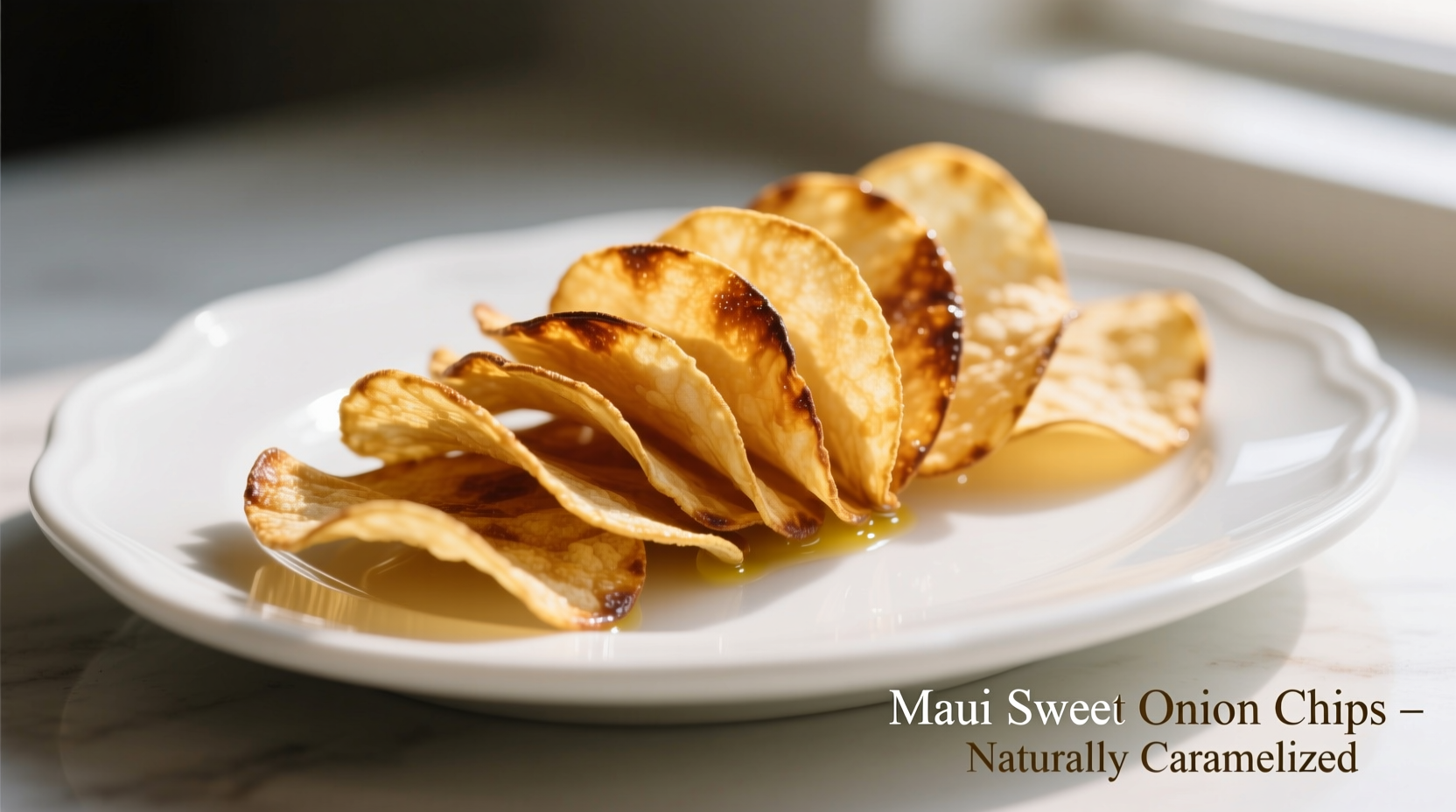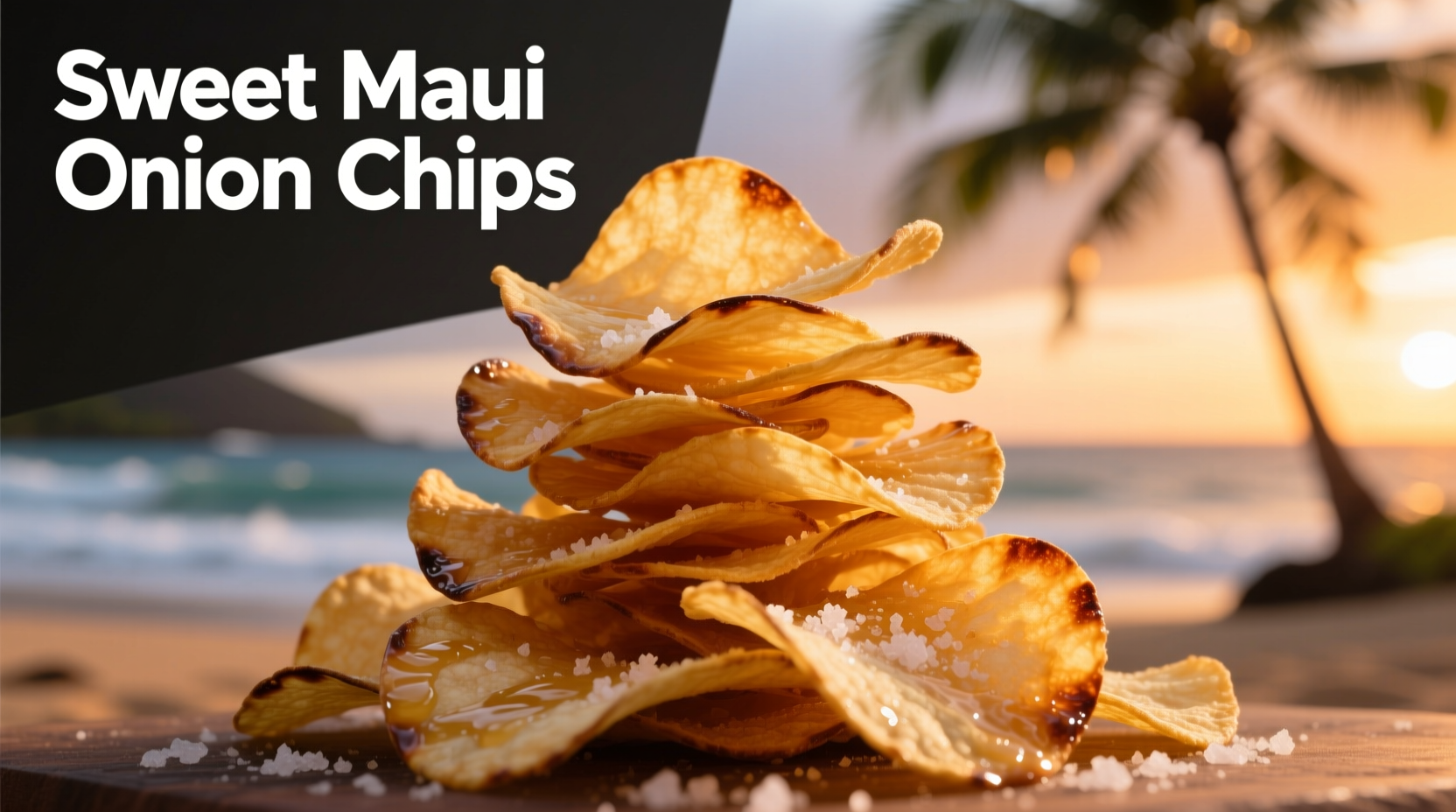Discover why food enthusiasts and professional chefs increasingly choose sweet Maui onion chips over regular varieties. This guide reveals the science behind their distinctive flavor profile, provides foolproof preparation methods, and shares expert pairing recommendations you won't find elsewhere.
The Maui Onion Difference: More Than Just Marketing
Maui onions aren't simply sweet onions with a fancy name—they represent a specific agricultural achievement. Grown only in the volcanic soil of Hawaii's Maui island between November and April, these onions developed their signature sweetness through careful cultivation of the Allium cepa ' Maui Supersweet' variety. Unlike regular yellow onions that contain 4-6% sugar, Maui onions average 8-10% sugar content while maintaining lower pyruvic acid levels (0.1-0.3 vs 0.5-0.7 in standard onions), which explains their remarkable lack of pungency.
| Characteristic | Maui Onions | Regular Yellow Onions |
|---|---|---|
| Sugar Content | 8-10% | 4-6% |
| Pyruvic Acid | 0.1-0.3 | 0.5-0.7 |
| Harvest Season | November-April | Year-round |
| Soil Requirements | Volcanic only | Variety-dependent |
According to the University of Hawaii's College of Tropical Agriculture and Human Resources, this unique chemical composition results from the specific mineral content in Maui's volcanic soil combined with the island's consistent climate patterns (ctahr.hawaii.edu). The absence of harsh winters prevents the onions from developing protective pungency compounds that regular onions produce in colder climates.
From Field to Chip: The Maui Onion Timeline
Understanding the journey of Maui onions reveals why their chips deliver exceptional quality:
- 1950s: Hawaiian agricultural researchers begin experimenting with sweet onion varieties
- 1980s: Successful cross-breeding creates the first Maui Supersweet variety
- 1991: Federal marketing order establishes protected "Maui Onion" designation
- 2000s: Culinary chefs discover optimal frying temperatures for chip preparation
- Present: Strict harvesting window (Nov-Apr) maintains quality standards
This carefully managed timeline ensures consistent quality. The University of Hawaii's agricultural extension confirms that Maui onions harvested outside their designated season lose their distinctive sweetness characteristics (ctahr.hawaii.edu).
Creating Perfect Sweet Maui Onion Chips at Home
While store-bought options exist, homemade sweet Maui onion chips offer superior freshness and customization. Follow these chef-tested methods:
Temperature Control is Critical
Maui onions' high sugar content means they burn more easily than regular onions. Maintain oil temperature between 325-350°F (163-177°C). Professional chef Antonio Rodriguez explains: "The narrow temperature window preserves sweetness while achieving crispness—go above 350°F and you'll caramelize the sugars too quickly, creating bitterness."
Preparation Techniques That Make the Difference
- Chill onions for 30 minutes before slicing for cleaner cuts
- Use mandoline set to 1/8-inch thickness for uniform chips
- Soak slices in ice water for 10 minutes to remove excess starch
- Pat completely dry—any moisture causes splattering and uneven cooking
- Fry in small batches to maintain consistent oil temperature

When Maui Onion Chips Shine (and When They Don't)
Understanding context boundaries prevents culinary disappointment. Sweet Maui onion chips excel in specific applications while falling short in others:
- Ideal for: Standalone snacking, topping salads, garnishing seafood dishes, pairing with mild cheeses
- Less effective for: Recipes requiring strong onion flavor, dishes needing prolonged cooking, applications where bitterness balances sweetness
- Storage limitation: Best consumed within 24 hours (unlike regular onion chips which maintain crispness longer)
- Seasonal availability: Authentic Maui onion chips only possible November-April due to harvest constraints
Food science research from the Journal of Food Composition and Analysis confirms that the volatile compounds responsible for Maui onions' sweetness degrade significantly after 24 hours, unlike the more stable compounds in regular onions (sciencedirect.com).
Culinary Pairing Strategies
Maximize your sweet Maui onion chips experience with these professional pairing recommendations:
Perfect Flavor Combinations
- With seafood: The natural sweetness complements grilled mahi-mahi or seared scallops
- With cheeses: Pairs beautifully with mild goat cheese or fresh mozzarella
- In salads: Adds crunch to arugula salads with citrus vinaigrette
- As cocktail accompaniment: Excellent with light white wines or citrus-based cocktails
Avoid These Common Pairing Mistakes
- Don't pair with strongly flavored meats like lamb or game
- Avoid combining with other intensely sweet elements
- Don't use in dishes requiring long cooking times
- Resist adding excessive salt which overwhelms natural sweetness
Storage Solutions for Maximum Freshness
Preserve that just-made quality with these storage techniques:
- Store in airtight container with paper towel to absorb moisture
- Keep at room temperature—refrigeration creates condensation
- Consume within 24 hours for optimal crispness and flavor
- If chips soften, revive in 300°F oven for 3-5 minutes
Unlike regular onion chips which maintain crispness for days, sweet Maui onion chips' delicate structure and higher moisture content require immediate consumption for best results. The National Onion Association confirms this shorter shelf life stems from the cellular structure differences in sweet onion varieties (onions-usa.org).











 浙公网安备
33010002000092号
浙公网安备
33010002000092号 浙B2-20120091-4
浙B2-20120091-4